Abstract
The highly polymorphic B-G antigens are considered to be part of the major histocompatibility complex (MHC) of the chicken, the B system of histocompatibility, because they are encoded in a family of genes tightly linked with the genes encoding MHC class I and class II antigens. To better understand these unusual MHC antigens, full-length B-G cDNA clones were isolated from B21 embryonic erythroid cell cDNA library, restriction-mapped, and sequenced. Five transcript types were identified. Analysis of the deduced amino acid sequences suggests that the B-G polypeptides are composed of single extracellular domains that resemble immunoglobulin domains of the variable-region (V) type, single membrane-spanning domains typical of integral membrane proteins, and long cytoplasmic tails. Sequence diversity among the five transcript types was found in all domains, notably including the B-G immunoglobulin V-like domains. The cytoplasmic tails of the B-G antigens are made up entirely of units of seven amino acid residues (heptads) that are typical of an alpha-helical coiled-coil conformation. The heptads vary in number and sequence between the different transcripts. The presence within B-G polypeptides of polymorphic immunoglobulin V-like domains warrants further investigations to determine the degree and nature of variability within this domain in these unusual MHC antigens.
Full text
PDF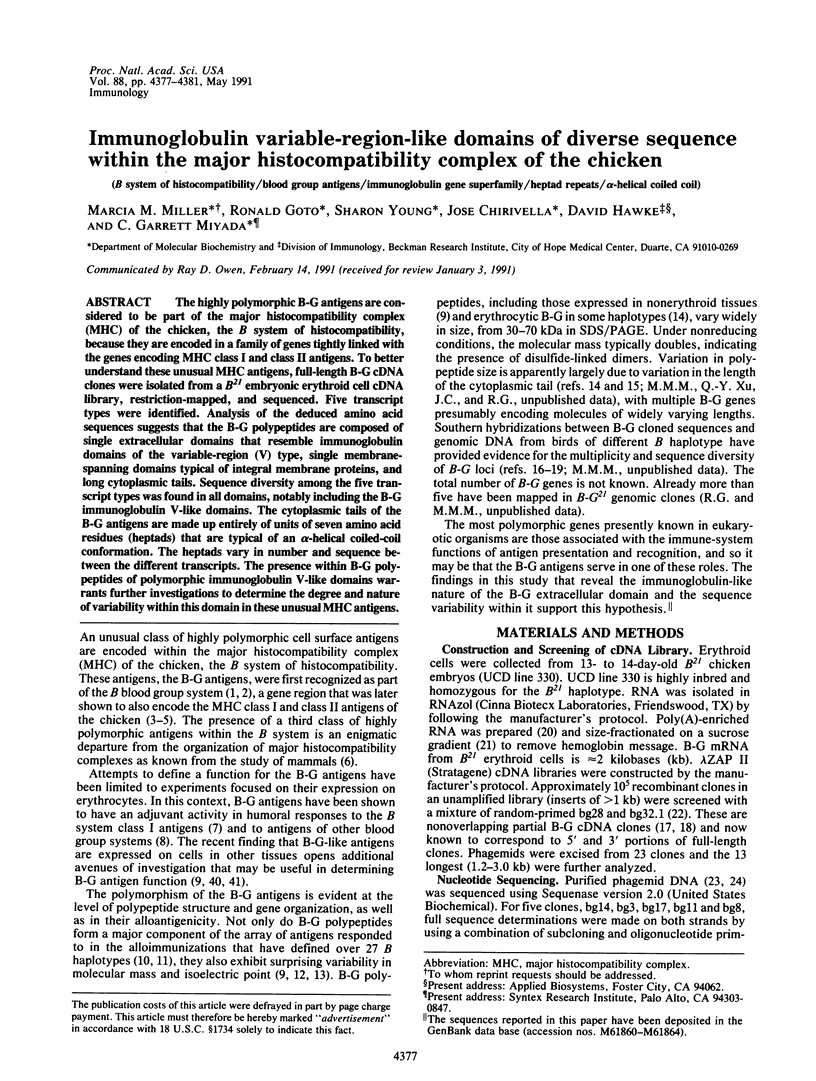
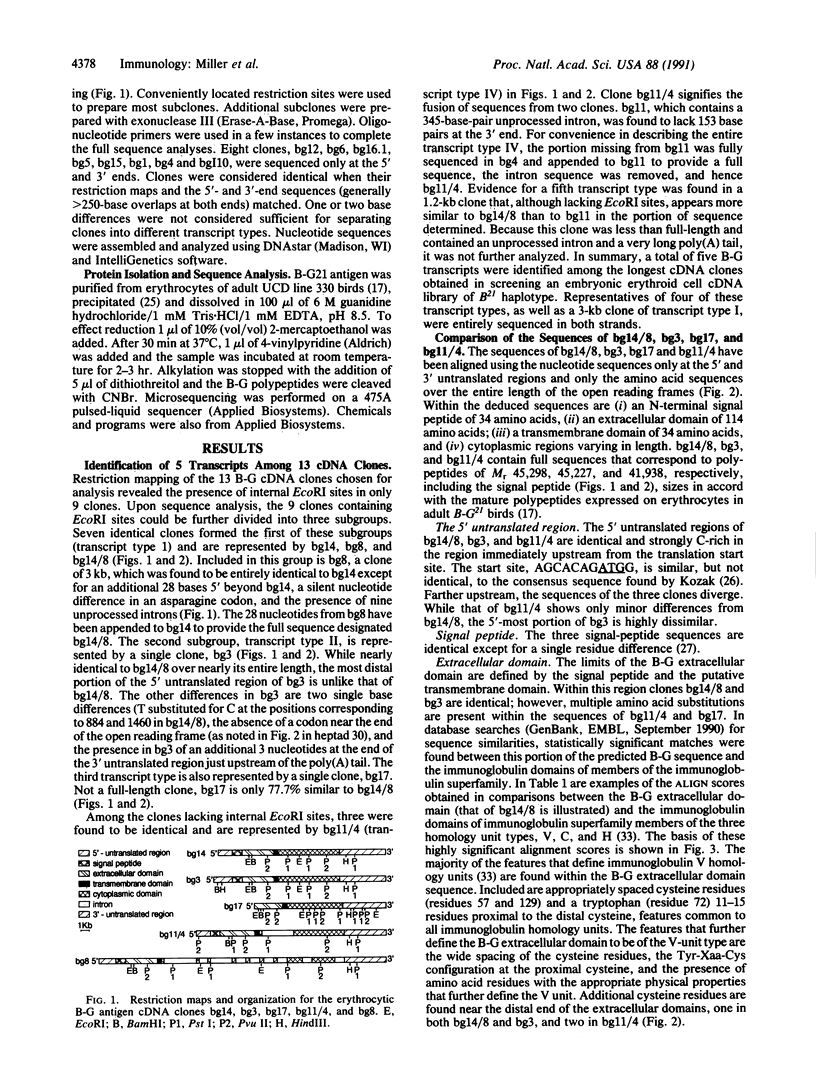
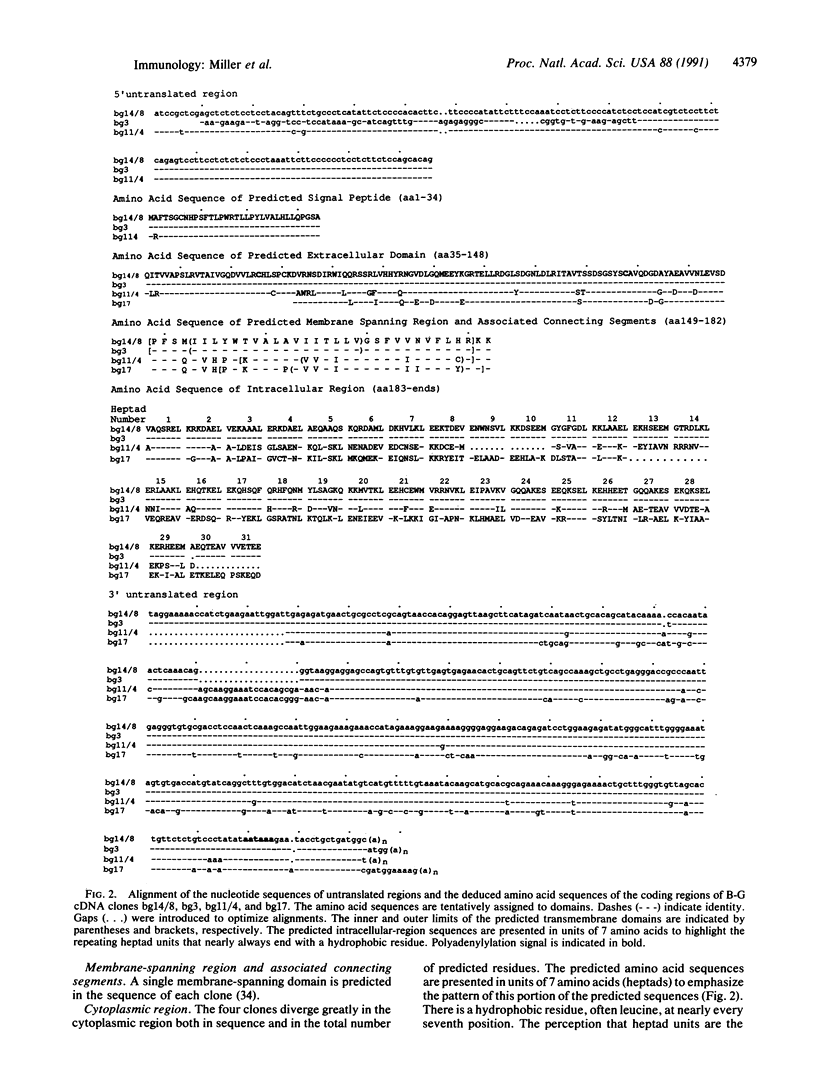
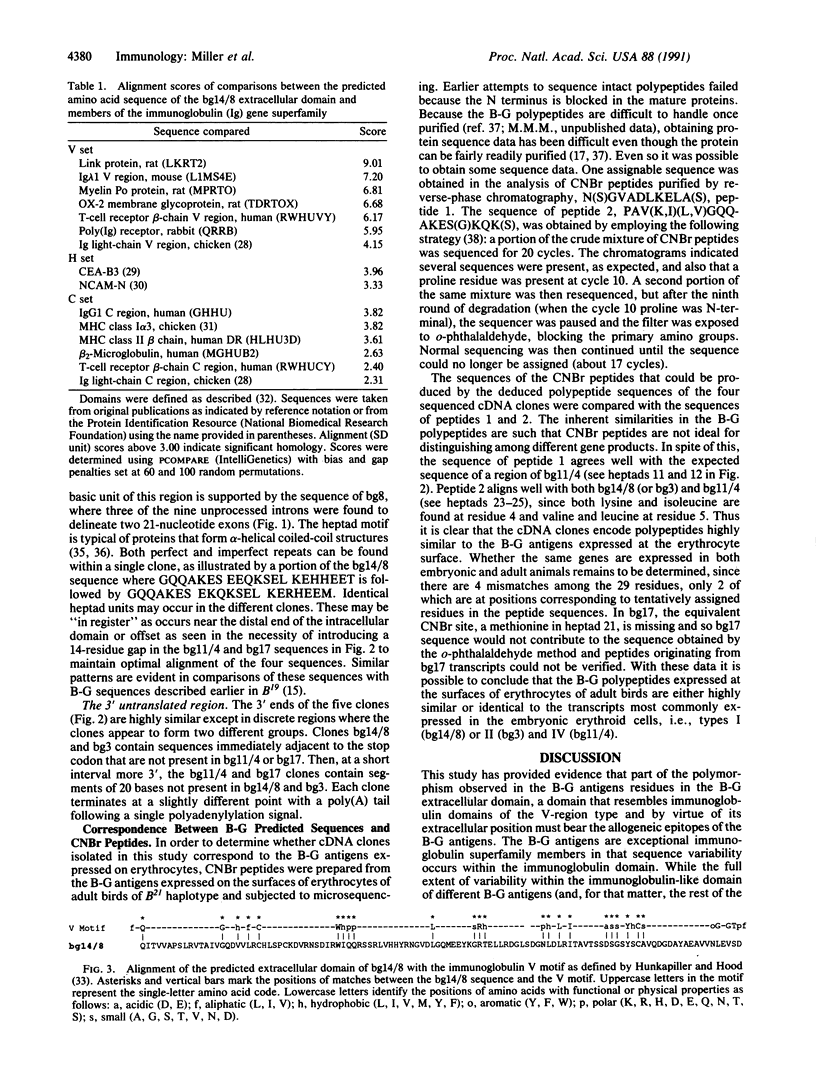
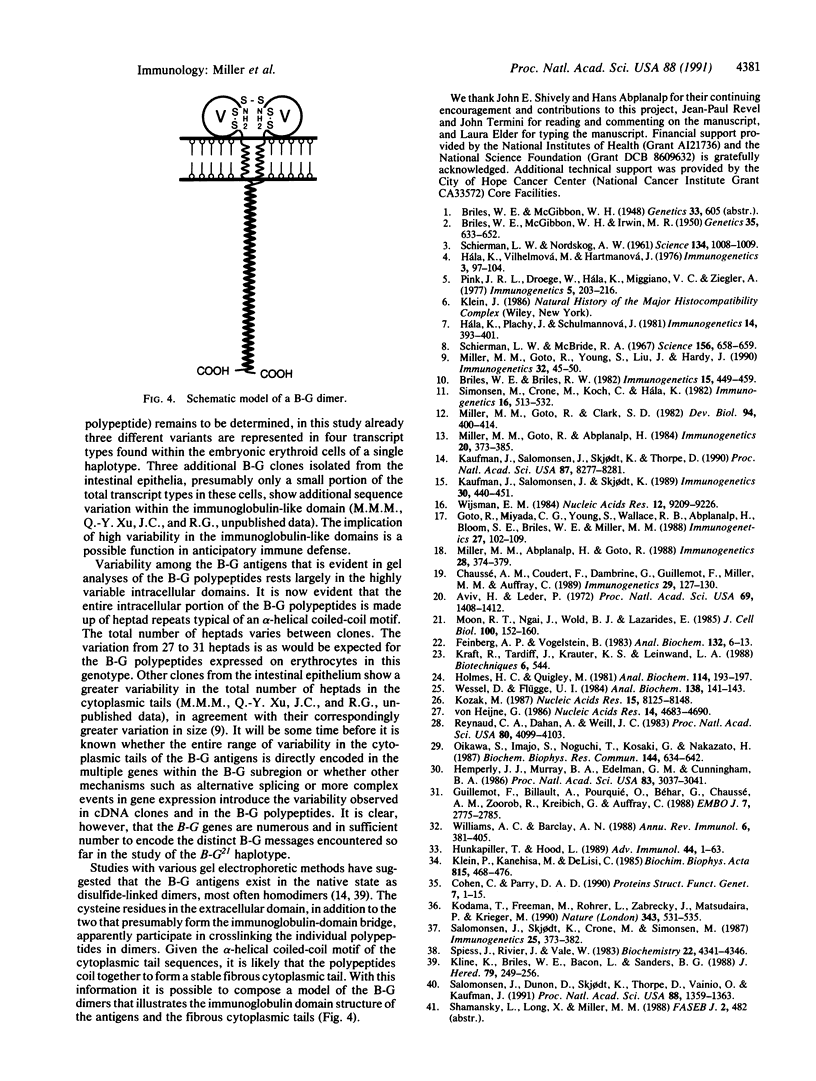
Selected References
These references are in PubMed. This may not be the complete list of references from this article.
- Aviv H., Leder P. Purification of biologically active globin messenger RNA by chromatography on oligothymidylic acid-cellulose. Proc Natl Acad Sci U S A. 1972 Jun;69(6):1408–1412. doi: 10.1073/pnas.69.6.1408. [DOI] [PMC free article] [PubMed] [Google Scholar]
- BRILES W. E., McGIBBON W. H., IRWIN M. R. On multiple alleles effecting cellular antigens in the chicken. Genetics. 1950 Nov;35(6):633–652. doi: 10.1093/genetics/35.6.633. [DOI] [PMC free article] [PubMed] [Google Scholar]
- Briles W. E., Briles R. W. Identification of haplotypes of the chicken major histocompatibility complex (B). Immunogenetics. 1982;15(5):449–459. doi: 10.1007/BF00345904. [DOI] [PubMed] [Google Scholar]
- Chaussé A. M., Coudert F., Dambrine G., Guillemot F., Miller M. M., Auffray C. Molecular genotyping of four chicken B-complex haplotypes with B-L beta, B-F, and B-G probes. Immunogenetics. 1989;29(2):127–130. doi: 10.1007/BF00395863. [DOI] [PubMed] [Google Scholar]
- Cohen C., Parry D. A. Alpha-helical coiled coils and bundles: how to design an alpha-helical protein. Proteins. 1990;7(1):1–15. doi: 10.1002/prot.340070102. [DOI] [PubMed] [Google Scholar]
- Feinberg A. P., Vogelstein B. A technique for radiolabeling DNA restriction endonuclease fragments to high specific activity. Anal Biochem. 1983 Jul 1;132(1):6–13. doi: 10.1016/0003-2697(83)90418-9. [DOI] [PubMed] [Google Scholar]
- Goto R., Miyada C. G., Young S., Wallace R. B., Abplanalp H., Bloom S. E., Briles W. E., Miller M. M. Isolation of a cDNA clone from the B-G subregion of the chicken histocompatibility (B) complex. Immunogenetics. 1988;27(2):102–109. doi: 10.1007/BF00351083. [DOI] [PubMed] [Google Scholar]
- Guillemot F., Billault A., Pourquié O., Béhar G., Chaussé A. M., Zoorob R., Kreibich G., Auffray C. A molecular map of the chicken major histocompatibility complex: the class II beta genes are closely linked to the class I genes and the nucleolar organizer. EMBO J. 1988 Sep;7(9):2775–2785. doi: 10.1002/j.1460-2075.1988.tb03132.x. [DOI] [PMC free article] [PubMed] [Google Scholar]
- Hemperly J. J., Murray B. A., Edelman G. M., Cunningham B. A. Sequence of a cDNA clone encoding the polysialic acid-rich and cytoplasmic domains of the neural cell adhesion molecule N-CAM. Proc Natl Acad Sci U S A. 1986 May;83(9):3037–3041. doi: 10.1073/pnas.83.9.3037. [DOI] [PMC free article] [PubMed] [Google Scholar]
- Holmes D. S., Quigley M. A rapid boiling method for the preparation of bacterial plasmids. Anal Biochem. 1981 Jun;114(1):193–197. doi: 10.1016/0003-2697(81)90473-5. [DOI] [PubMed] [Google Scholar]
- Hunkapiller T., Hood L. Diversity of the immunoglobulin gene superfamily. Adv Immunol. 1989;44:1–63. doi: 10.1016/s0065-2776(08)60639-2. [DOI] [PubMed] [Google Scholar]
- Hála K., Plachý J., Schulmannová J. Role of the B-G-region antigen in the humoral immune response to the B-F-region antigen of chicken MHC. Immunogenetics. 1981;14(5):393–401. doi: 10.1007/BF00373319. [DOI] [PubMed] [Google Scholar]
- Kaufman J., Salomonsen J., Skjødt K. B-G cDNA clones have multiple small repeats and hybridize to both chicken MHC regions. Immunogenetics. 1989;30(6):440–451. doi: 10.1007/BF02421176. [DOI] [PubMed] [Google Scholar]
- Kaufman J., Salomonsen J., Skjødt K., Thorpe D. Size polymorphism of chicken major histocompatibility complex-encoded B-G molecules is due to length variation in the cytoplasmic heptad repeat region. Proc Natl Acad Sci U S A. 1990 Nov;87(21):8277–8281. doi: 10.1073/pnas.87.21.8277. [DOI] [PMC free article] [PubMed] [Google Scholar]
- Klein P., Kanehisa M., DeLisi C. The detection and classification of membrane-spanning proteins. Biochim Biophys Acta. 1985 May 28;815(3):468–476. doi: 10.1016/0005-2736(85)90375-x. [DOI] [PubMed] [Google Scholar]
- Kline K., Briles W. E., Bacon L., Sanders B. G. Characterization of two distinct disulfide-linked B-G molecules in the chicken. J Hered. 1988 Jul-Aug;79(4):249–256. doi: 10.1093/oxfordjournals.jhered.a110505. [DOI] [PubMed] [Google Scholar]
- Kodama T., Freeman M., Rohrer L., Zabrecky J., Matsudaira P., Krieger M. Type I macrophage scavenger receptor contains alpha-helical and collagen-like coiled coils. Nature. 1990 Feb 8;343(6258):531–535. doi: 10.1038/343531a0. [DOI] [PubMed] [Google Scholar]
- Kozak M. An analysis of 5'-noncoding sequences from 699 vertebrate messenger RNAs. Nucleic Acids Res. 1987 Oct 26;15(20):8125–8148. doi: 10.1093/nar/15.20.8125. [DOI] [PMC free article] [PubMed] [Google Scholar]
- Kraft R., Tardiff J., Krauter K. S., Leinwand L. A. Using mini-prep plasmid DNA for sequencing double stranded templates with Sequenase. Biotechniques. 1988 Jun;6(6):544-6, 549. [PubMed] [Google Scholar]
- Miller M. M., Abplanalp H., Goto R. Genotyping chickens for the B-G subregion of the major histocompatibility complex using restriction fragment length polymorphisms. Immunogenetics. 1988;28(5):374–379. doi: 10.1007/BF00364237. [DOI] [PubMed] [Google Scholar]
- Miller M. M., Goto R., Abplanalp H. Analysis of the B-G antigens of the chicken MHC by two-dimensional gel electrophoresis. Immunogenetics. 1984;20(4):373–385. doi: 10.1007/BF00345612. [DOI] [PubMed] [Google Scholar]
- Miller M. M., Goto R., Clark S. D. Structural characterization of developmentally expressed antigenic markers on chicken erythrocytes using monoclonal antibodies. Dev Biol. 1982 Dec;94(2):400–414. doi: 10.1016/0012-1606(82)90357-8. [DOI] [PubMed] [Google Scholar]
- Miller M. M., Goto R., Young S., Liu J., Hardy J. Antigens similar to major histocompatibility complex B-G are expressed in the intestinal epithelium in the chicken. Immunogenetics. 1990;32(1):45–50. doi: 10.1007/BF01787328. [DOI] [PubMed] [Google Scholar]
- Moon R. T., Ngai J., Wold B. J., Lazarides E. Tissue-specific expression of distinct spectrin and ankyrin transcripts in erythroid and nonerythroid cells. J Cell Biol. 1985 Jan;100(1):152–160. doi: 10.1083/jcb.100.1.152. [DOI] [PMC free article] [PubMed] [Google Scholar]
- Oikawa S., Imajo S., Noguchi T., Kosaki G., Nakazato H. The carcinoembryonic antigen (CEA) contains multiple immunoglobulin-like domains. Biochem Biophys Res Commun. 1987 Apr 29;144(2):634–642. doi: 10.1016/s0006-291x(87)80013-x. [DOI] [PubMed] [Google Scholar]
- Reynaud C. A., Dahan A., Weill J. C. Complete sequence of a chicken lambda light chain immunoglobulin derived from the nucleotide sequence of its mRNA. Proc Natl Acad Sci U S A. 1983 Jul;80(13):4099–4103. doi: 10.1073/pnas.80.13.4099. [DOI] [PMC free article] [PubMed] [Google Scholar]
- SCHIERMAN L. W., NORDSKOG A. W. Relationship of blood type to histocompatibility in chickens. Science. 1961 Oct 6;134(3484):1008–1009. doi: 10.1126/science.134.3484.1008. [DOI] [PubMed] [Google Scholar]
- Salomonsen J., Dunon D., Skjødt K., Thorpe D., Vainio O., Kaufman J. Chicken major histocompatibility complex-encoded B-G antigens are found on many cell types that are important for the immune system. Proc Natl Acad Sci U S A. 1991 Feb 15;88(4):1359–1363. doi: 10.1073/pnas.88.4.1359. [DOI] [PMC free article] [PubMed] [Google Scholar]
- Salomonsen J., Skjødt K., Crone M., Simonsen M. The chicken erythrocyte-specific MHC antigen. Characterization and purification of the B-G antigen by monoclonal antibodies. Immunogenetics. 1987;25(6):373–382. doi: 10.1007/BF00396103. [DOI] [PubMed] [Google Scholar]
- Schierman L. W., McBride R. A. Adjuvant activity of erythrocyte isoantigens. Science. 1967 May 5;156(3775):658–659. doi: 10.1126/science.156.3775.658. [DOI] [PubMed] [Google Scholar]
- Simonsen M., Crone M., Koch C., Hála K. The MHC haplotypes of the chicken. Immunogenetics. 1982;16(6):513–532. doi: 10.1007/BF00372021. [DOI] [PubMed] [Google Scholar]
- Spiess J., Rivier J., Vale W. Sequence analysis of rat hypothalamic corticotropin-releasing factor with the o-phthalaldehyde strategy. Biochemistry. 1983 Aug 30;22(18):4341–4346. doi: 10.1021/bi00287a027. [DOI] [PubMed] [Google Scholar]
- Wessel D., Flügge U. I. A method for the quantitative recovery of protein in dilute solution in the presence of detergents and lipids. Anal Biochem. 1984 Apr;138(1):141–143. doi: 10.1016/0003-2697(84)90782-6. [DOI] [PubMed] [Google Scholar]
- Wijsman E. M. Optimizing selection of restriction enzymes in the search for DNA variants. Nucleic Acids Res. 1984 Dec 11;12(23):9209–9226. doi: 10.1093/nar/12.23.9209. [DOI] [PMC free article] [PubMed] [Google Scholar]
- Williams A. F., Barclay A. N. The immunoglobulin superfamily--domains for cell surface recognition. Annu Rev Immunol. 1988;6:381–405. doi: 10.1146/annurev.iy.06.040188.002121. [DOI] [PubMed] [Google Scholar]
- von Heijne G. A new method for predicting signal sequence cleavage sites. Nucleic Acids Res. 1986 Jun 11;14(11):4683–4690. doi: 10.1093/nar/14.11.4683. [DOI] [PMC free article] [PubMed] [Google Scholar]


